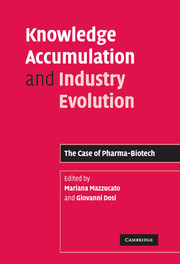Book contents
- Frontmatter
- Contents
- List of figures
- List of tables
- List of contributors
- Acknowledgments
- 1 Introduction
- Part I Innovation and industry evolution
- Part II Firm growth and market structure
- Part III Policy implications
- 10 The effects of research tool patents and licensing on biomedical innovation
- 11 Upstream patents and public health: the case of genetic testing for breast cancer
- 12 Competition, regulation, and intellectual property management in genetically modified foods: evidence from survey data
- 13 Governance, policy, and industry strategies: pharmaceuticals and agro-biotechnology
- 14 The dynamics of knowledge accumulation, regulation, and appropriability in the pharma-biotech sector: policy issues
- Index
- References
14 - The dynamics of knowledge accumulation, regulation, and appropriability in the pharma-biotech sector: policy issues
Published online by Cambridge University Press: 22 September 2009
- Frontmatter
- Contents
- List of figures
- List of tables
- List of contributors
- Acknowledgments
- 1 Introduction
- Part I Innovation and industry evolution
- Part II Firm growth and market structure
- Part III Policy implications
- 10 The effects of research tool patents and licensing on biomedical innovation
- 11 Upstream patents and public health: the case of genetic testing for breast cancer
- 12 Competition, regulation, and intellectual property management in genetically modified foods: evidence from survey data
- 13 Governance, policy, and industry strategies: pharmaceuticals and agro-biotechnology
- 14 The dynamics of knowledge accumulation, regulation, and appropriability in the pharma-biotech sector: policy issues
- Index
- References
Summary
The contributions to this book enrich from a variety of angles our understanding of how the dynamics of knowledge affect the dynamics of firms and industry structures. In this concluding chapter, we discuss some associated policy implications regarding the future of the innovation process in the pharmaceutical industry and the institutional setup supporting it.
Institutions, industry organization, and innovation: a bird's-eye view
The policy debate in this arena has become extremely intense and often bitter in recent years. The issues at stake concern an area – health care – the importance of which for society is fundamental and rapidly increasing; indeed, they are becoming crucial elements in the very definition of notions such as welfare, justice, and democracy in the new century.
Many fundamental issues in the policy debate on the pharmaceutical industry, however, are certainly not new. Ever since its inception the market for drugs has been (almost) always and everywhere regulated, albeit for different reasons and in different ways. At the same time, the extent and the forms of the regulation have most often sparked discussion and conflict. For example, considerations linked to consumer protection led, throughout most of the twentieth century, to increasingly stringent requirements for the approval of new drugs, and implied larger and more costly clinical trials. The presence of significant information asymmetries in the market for drugs coupled with fundamental considerations of social and economic equity have often been used to justify the introduction of various forms of price regulation.
- Type
- Chapter
- Information
- Knowledge Accumulation and Industry EvolutionThe Case of Pharma-Biotech, pp. 402 - 431Publisher: Cambridge University PressPrint publication year: 2006
References
- 9
- Cited by

